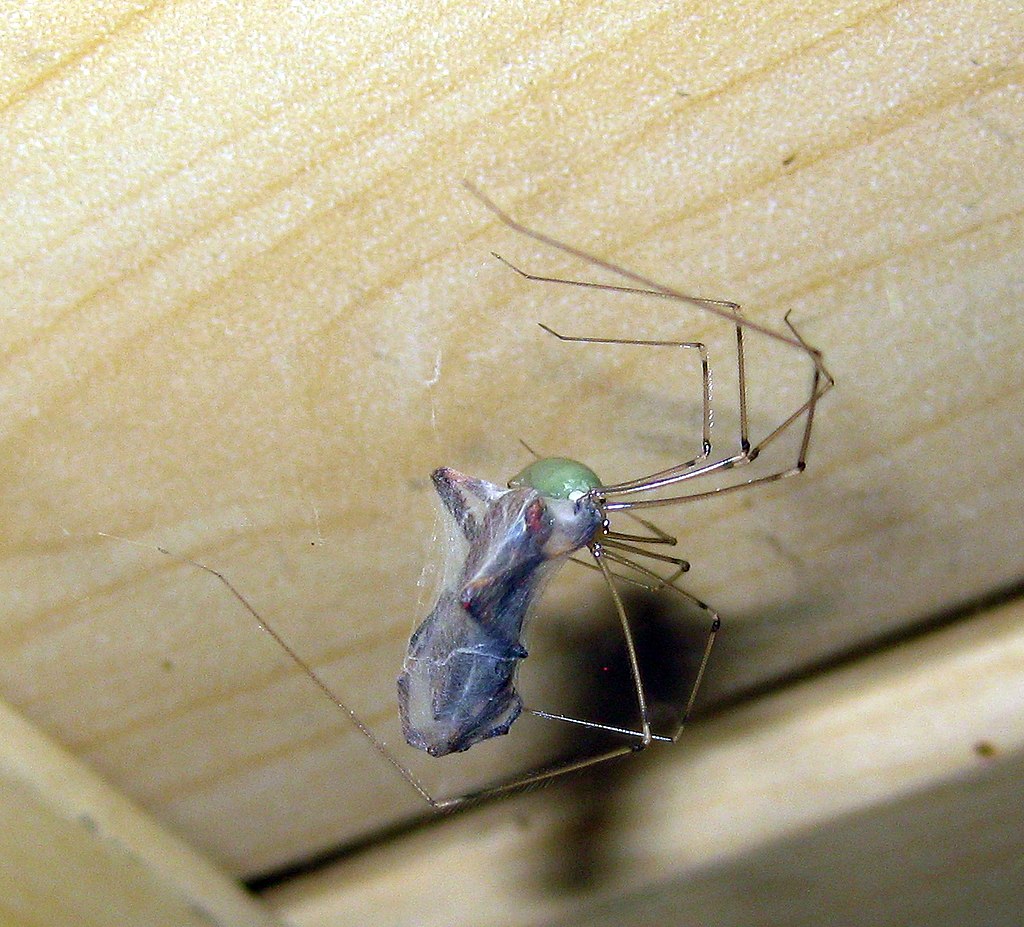Typical orb webs. Left: showing radial and spiral threads, the threads anchoring the structure within vegetation, and the central area where the spider may rest while awaiting prey. Right: a myriad orb webs showing above long grass on a late summer early morning, with dew revealing the webs.
Common orb-web spiders include the large and abundant garden spider Araneus diadematus, the orbweb spider Metellina segmentata and the long-jawed orbweb spider Tetragnatha montana. The missing-sector orbweb spider Zygiella x-notata, a relative of the garden spider, has a distinctive web with a roughly 60 degree sector "missing".
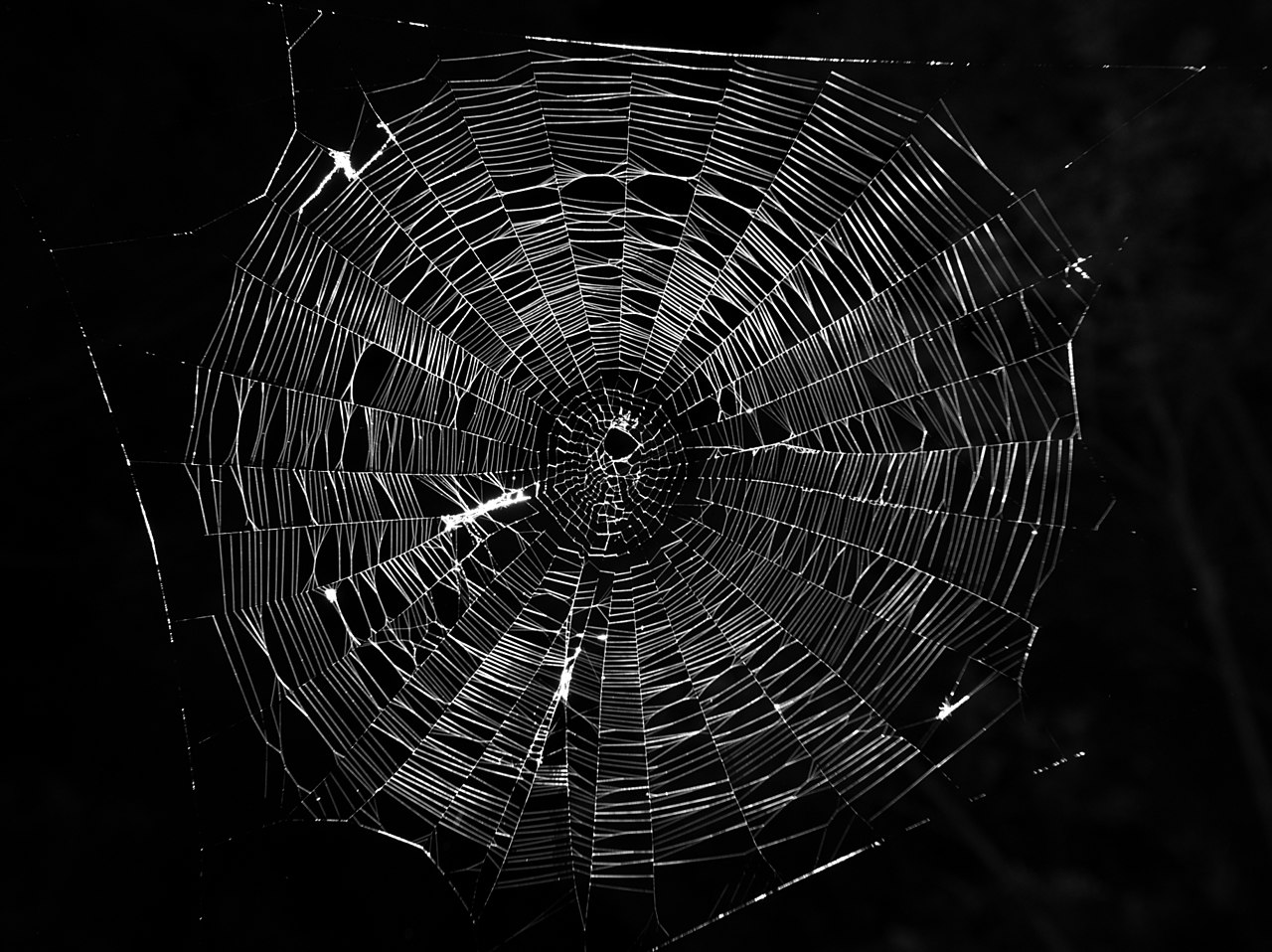

Web-building spiders
Web builders are the most familiar spiders for most people, because the webs - scruffy or beautiful and intricate, are so prominent in late summer and autumn, especially on misty or frosty mornings. All spiders have the capacity to make silk (as do many insects), but for web-builders the silk is essential for food procurement. Silk is as tough as nylon, but being made of protein, is "expensive" to produce, so a completed web is a significant investment. The orb web spiders also secrete special sticky silk which they deposit in small drops over the spiral web strands to trap insects. These spiders have an oily deposit on their legs that prvents them from getting stuck in their own trap.
Web building species in Britain and Ireland
Jennifer Owen recorded 50 web building spider species from five families in her Leicester garden. We will describe garden web spiders according to the style of web they produce, which can be orb, sheet, tangle, funnel, lace and radial types. The Natural History Museum has an excellent page on web types here, and this page is arranged folowing their example.
Orb webs are constructed with radial threads that function as a scaffold. The spider then lays down sticky threads in a spiral. Jennifer Owen found orb web spiders from the families Araneidae, and Tetragnathidae in her garden.
Sheet webs
Orb webs are generally vertical and trap flying insects, but sheet webs are essentially horizontal and catch insects falling into them. These densely woven, thin sheets look like silken hammocks adorning grass and low bushes. Bugs fall onto the hammocks or get knocked down when they collide with a tangle of threads above the sheet.
Sheet webs are usually built by the Linyphiidae. This is the largest family of spiders in the UK, with 280 species. It includes the tiny money spiders said to bring good luck if you find one wandering over you.
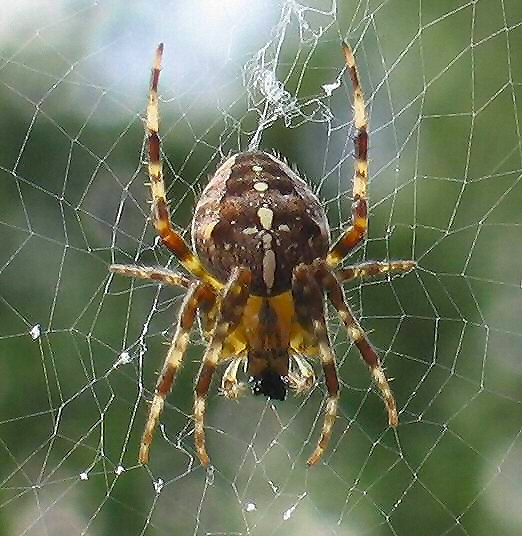
.jpg)
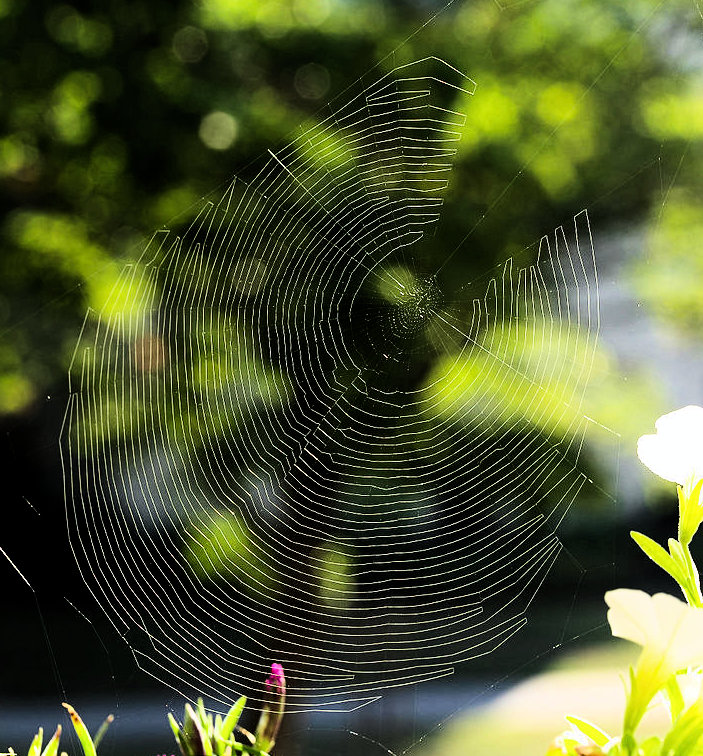
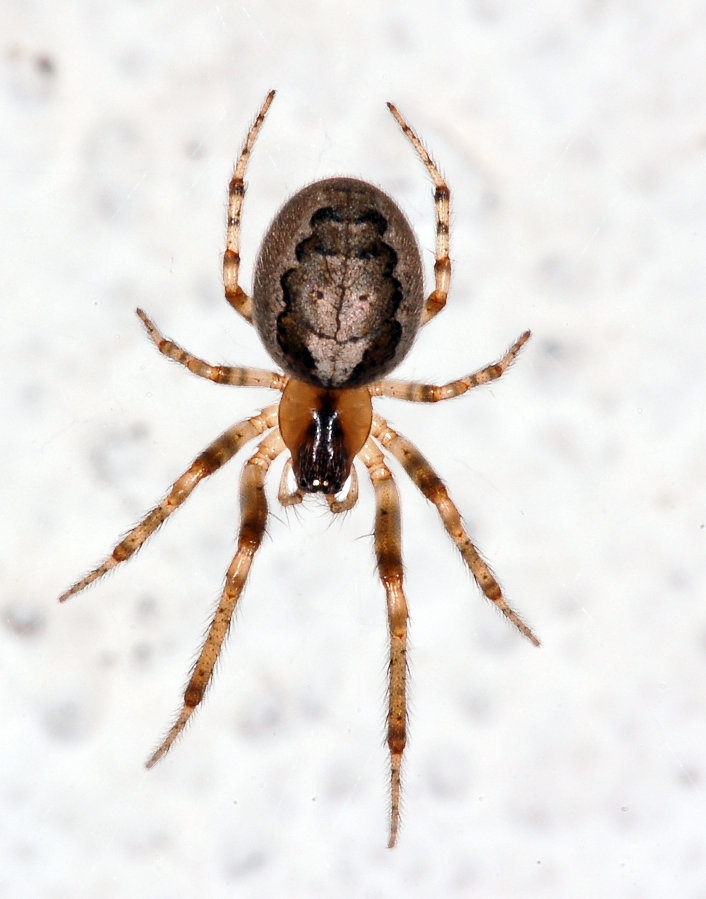
Above left: Garden spider Araneus diadematus Above right: Orbweb spider Metellina segmentata
Below left: Missing-sector orbweb spider Zygiella x-notata and (right) its characteristic web.
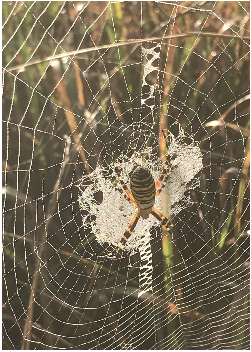
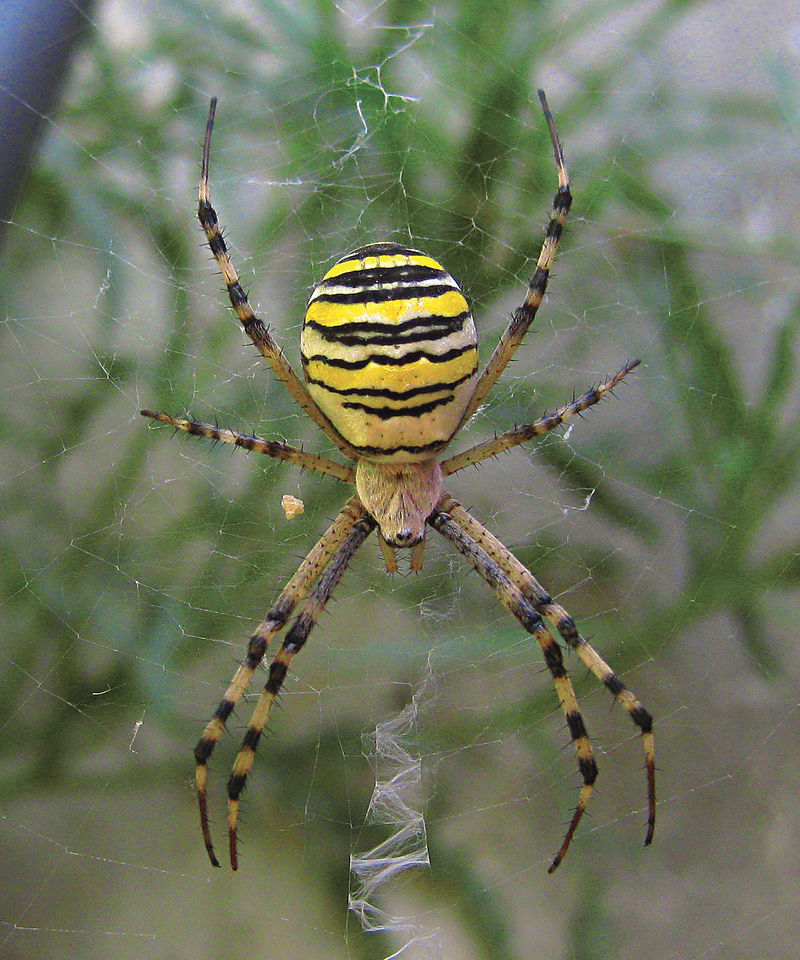
Below: the wasp spider Argiope bruennichi left: gravid female, right: on its web showing the stabilimentum
.jpg)
Long-jawed orbweb spider Tetragnatha montana
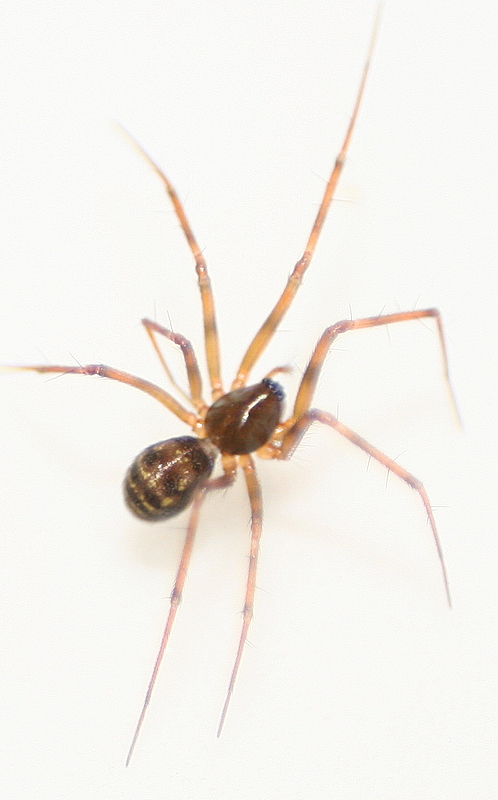
Left: Common sheetweb spider underneath its web. Right: money spider Lepthyphantes leprosus
Tangle or mesh webs
As their name suggests, these webs are an iregular 3D tangle of threads. Jennifer Owen found tangle-web spiders from two families of UK spiders: the Dictynidae and Theridiidae .
There are seven species of Dictynidae spider in the UK, of which Jennifer Owen found two. Like several other spider groups they create small, tangled meshes of cribellate or "wooly" silk. This is a non-sticky form of silk produced from spinnerets with many tiny orifices, each producing a single extremely thin strand which is woven in with others rather like rope. The webs ar often built covering flowers and leaves or among leaf litter.
Owen found 7 species of Theridiidae, including the common candy-striped spider Enoplognatha ovata and the comb-footed spider Steatoda bipunctata. This family contains the notorious black widow spiders, and every year the tabloid papers raise unwarranted scares about the noble false-widow spider Steatoda nobilis. This species was first found in England in the late nineteenth century, probably stowing away on a banana boat from its native Madeira and Canary Islands. With climate change, it has spread north from the south coast, and is closely connected with houses which it will enter in cold weather. It can just about pierce human skin, but the "bite" is no worse than a bee sting - but., like bee and wasp stings, can cause a strong immune reponse.
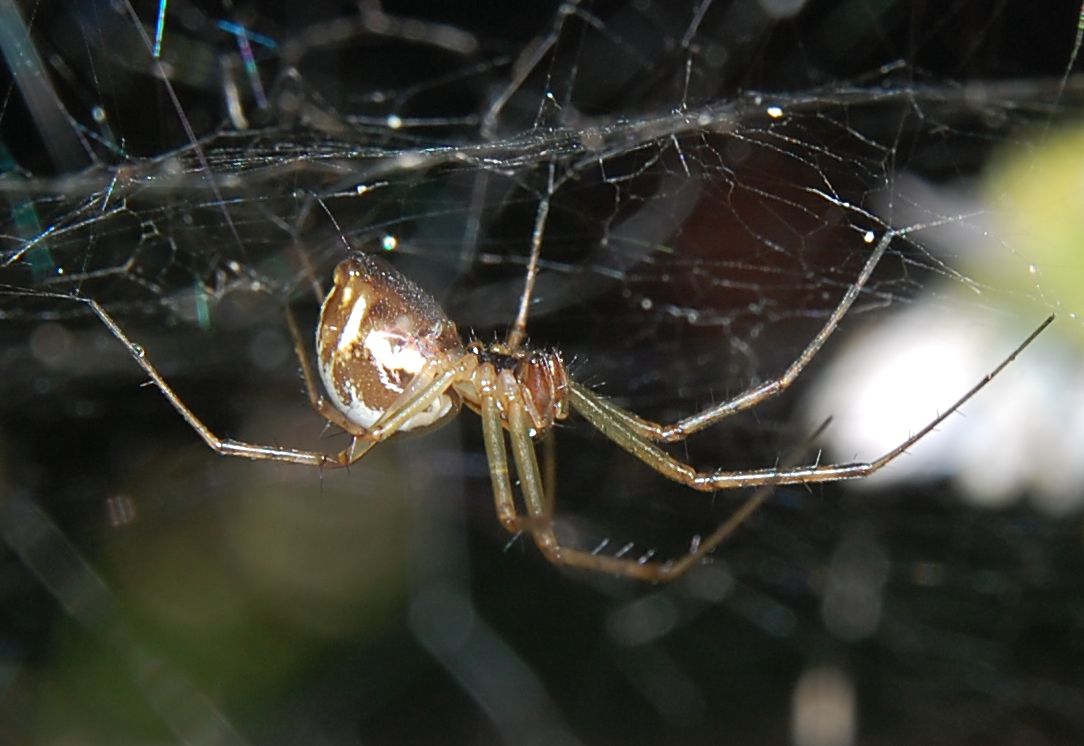
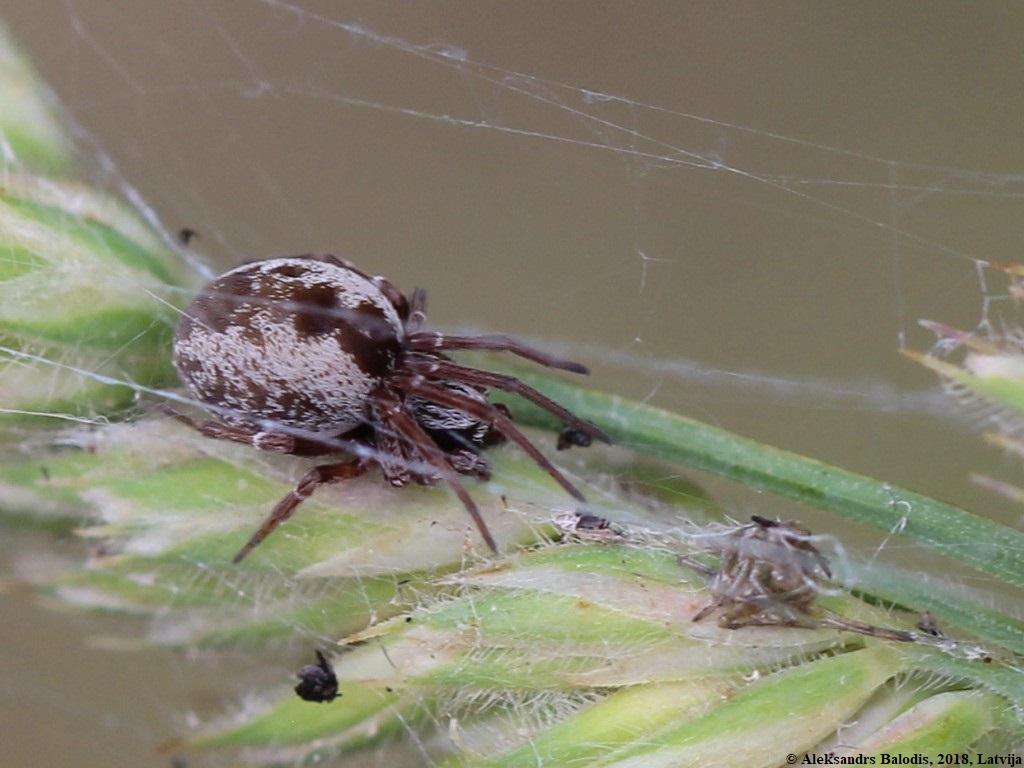
The Pholcidae or cellar-spiders is another tangle-web family. The daddy-long-legs spider Pholcus phalangioides has become common in warm centrally heated houses and has spread north in Britain. Although they favour dark secluded spaces like cellars or under baths, they are occasionally found in gardens. They are often seen in the corners of the ceilings of houses where they make sparse untidy (and generally unpopular) webs. They are easy to identify, from their very long legs and the way they vibrate rapidly up and down when you disturb them, becoming a blur.
In this photo the spider has captured and wrapped up a western conifer seed bug Leptoglossus occidentalis, which had ventured indoors to hibernate.
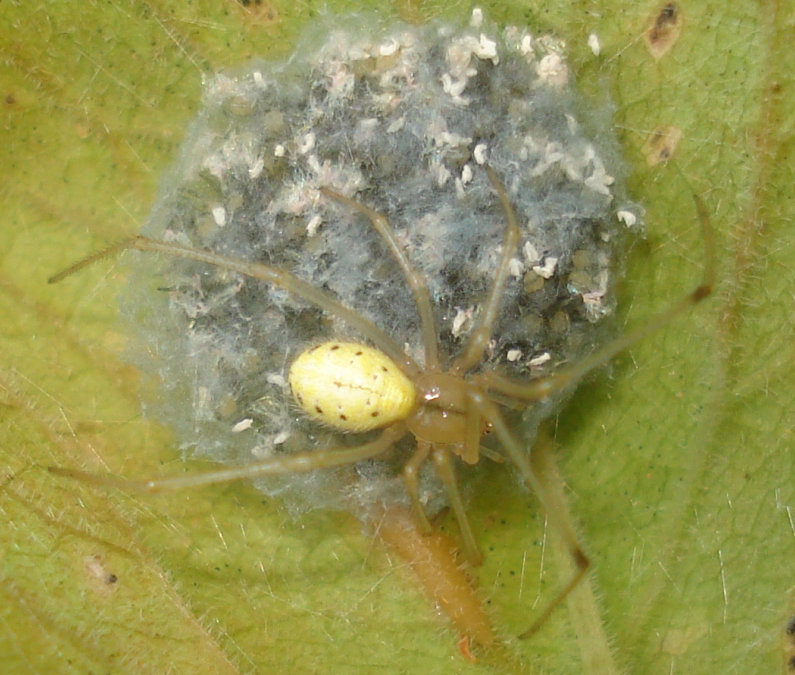
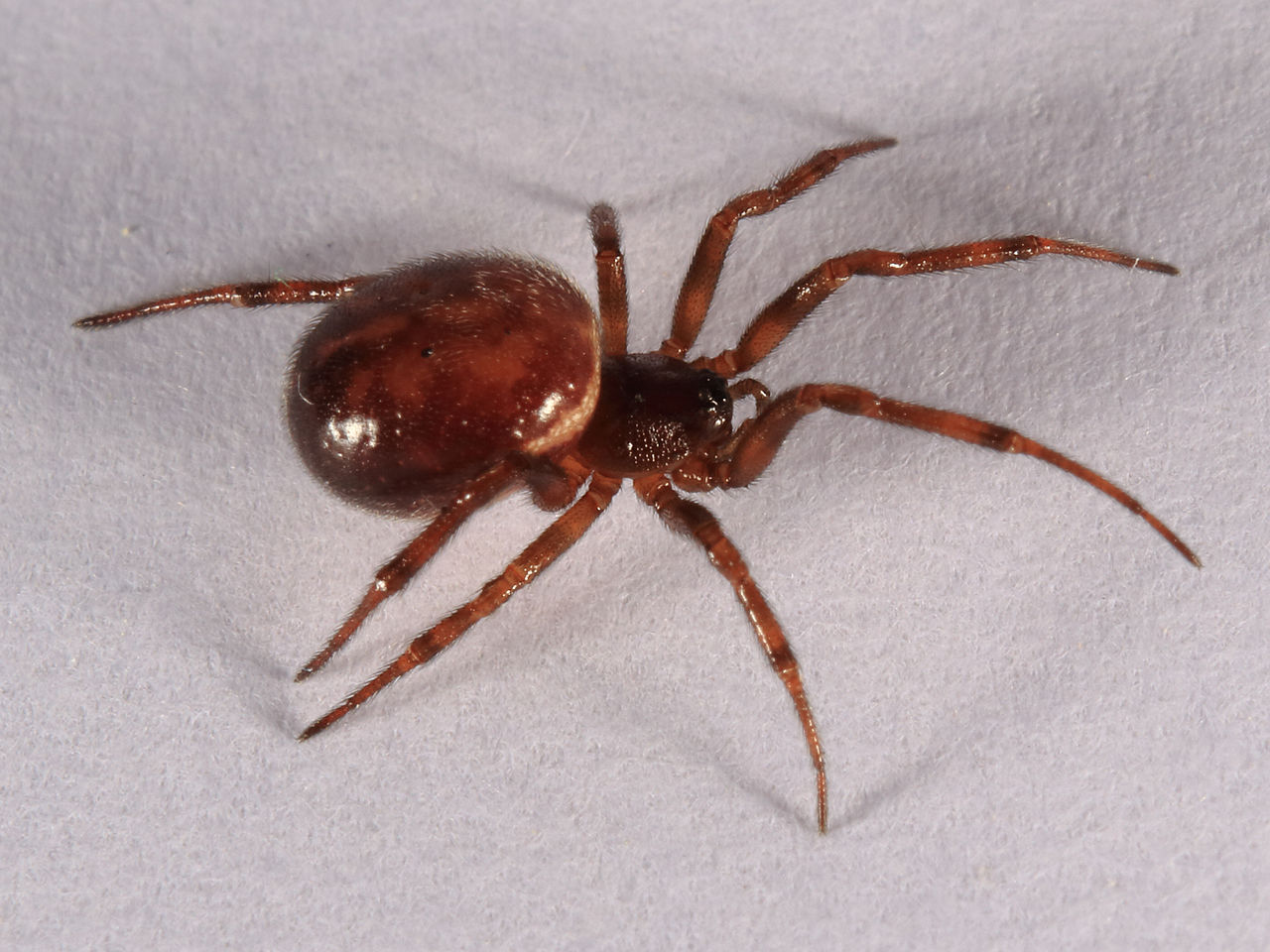
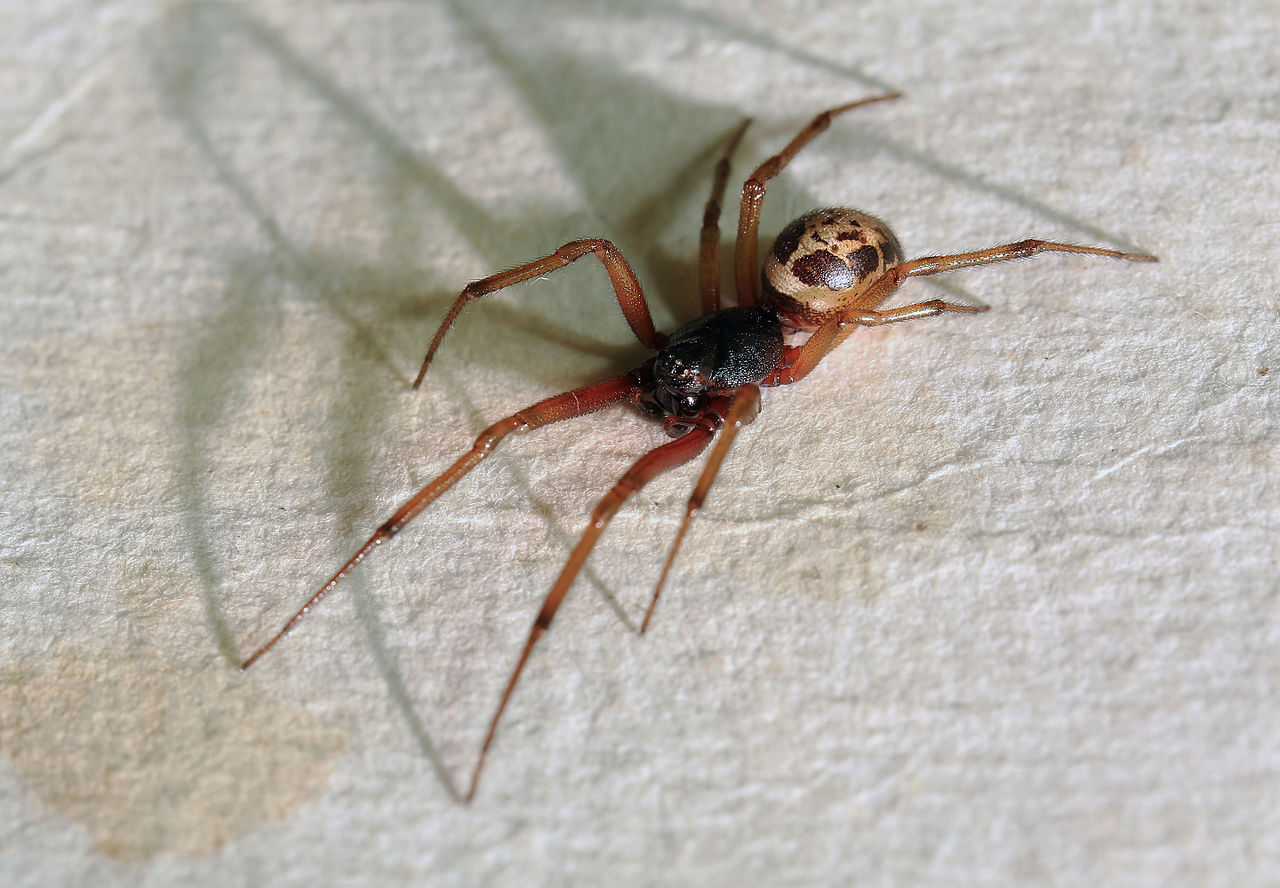
Above. Left: mesh-web spider Dictyna arundinacea showing the tangled web. Right: Common candy-striped spider Enoplognatha ovata with egg sac.
Below. Left: Comb-footed spider Steatoda bipunctata Right: Noble false widow spider Steatoda nobilis
Left: House spider Tegenaria gigantea lurking in its funnel web. Right: Tegenaria domestica
Lace webs also include a tubular retreat but they use cribellate or "woolly" with a lace-like appearance. The three British and Irish species are in the family Amaurodiidae, genus Amaurobius, and Jennifer Owen found all three. They spread their webs out around holes in walls, tree bark or fences, or under stones and in dense vegetation.
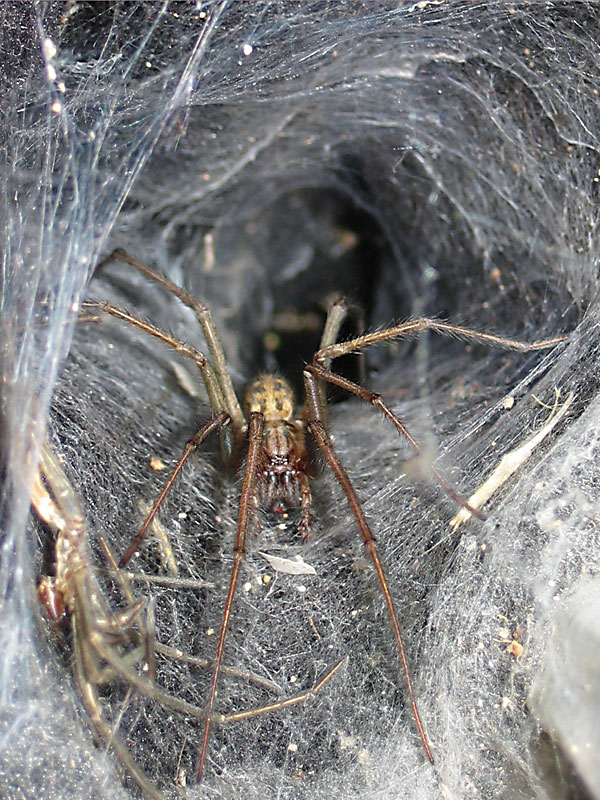
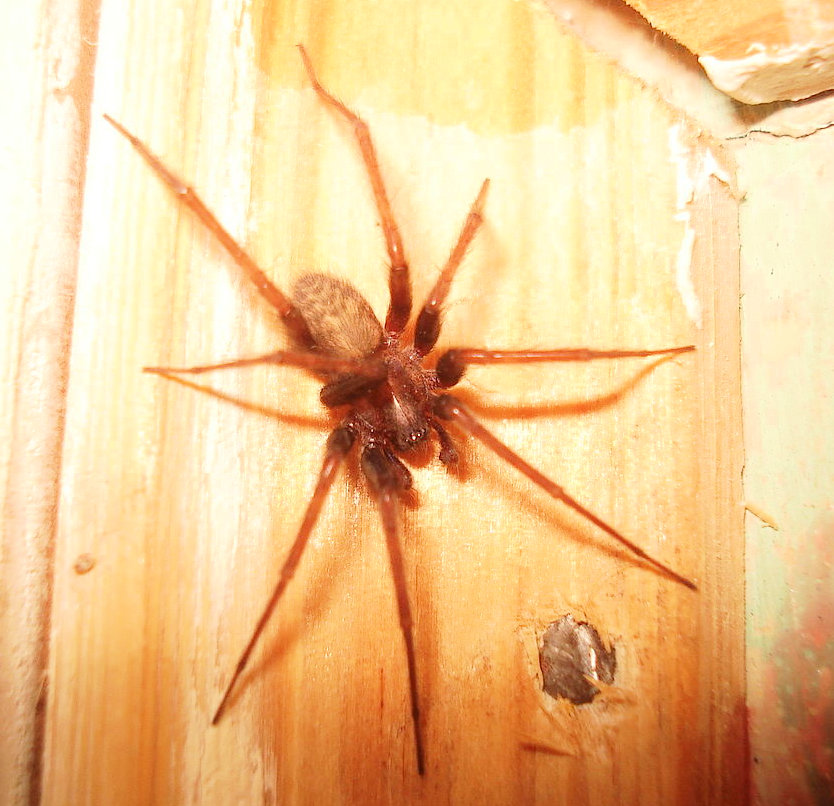
Lace web made by Amaurobius fenestralis Amaurobius similis
Radial webs
This web is centred on a silken tube, but with single lines of silk radiating away from it. These strands are not sticky to trap prey, but are trip-wires that signal the presence of prey to the urking spider, which then dashes out very quickly to catch it.
Only the family Segestriidae, with three species makes radial webs in Britain. Jennifer Owen did not encounter any in her study. The tube web spider Segestria florentina is one of our largest spiders, with females growing more than two centimetres long. Although restricted to southern England and Wales, mainly around old ports, reports suggest this originally Mediterranean species is spreading further inland
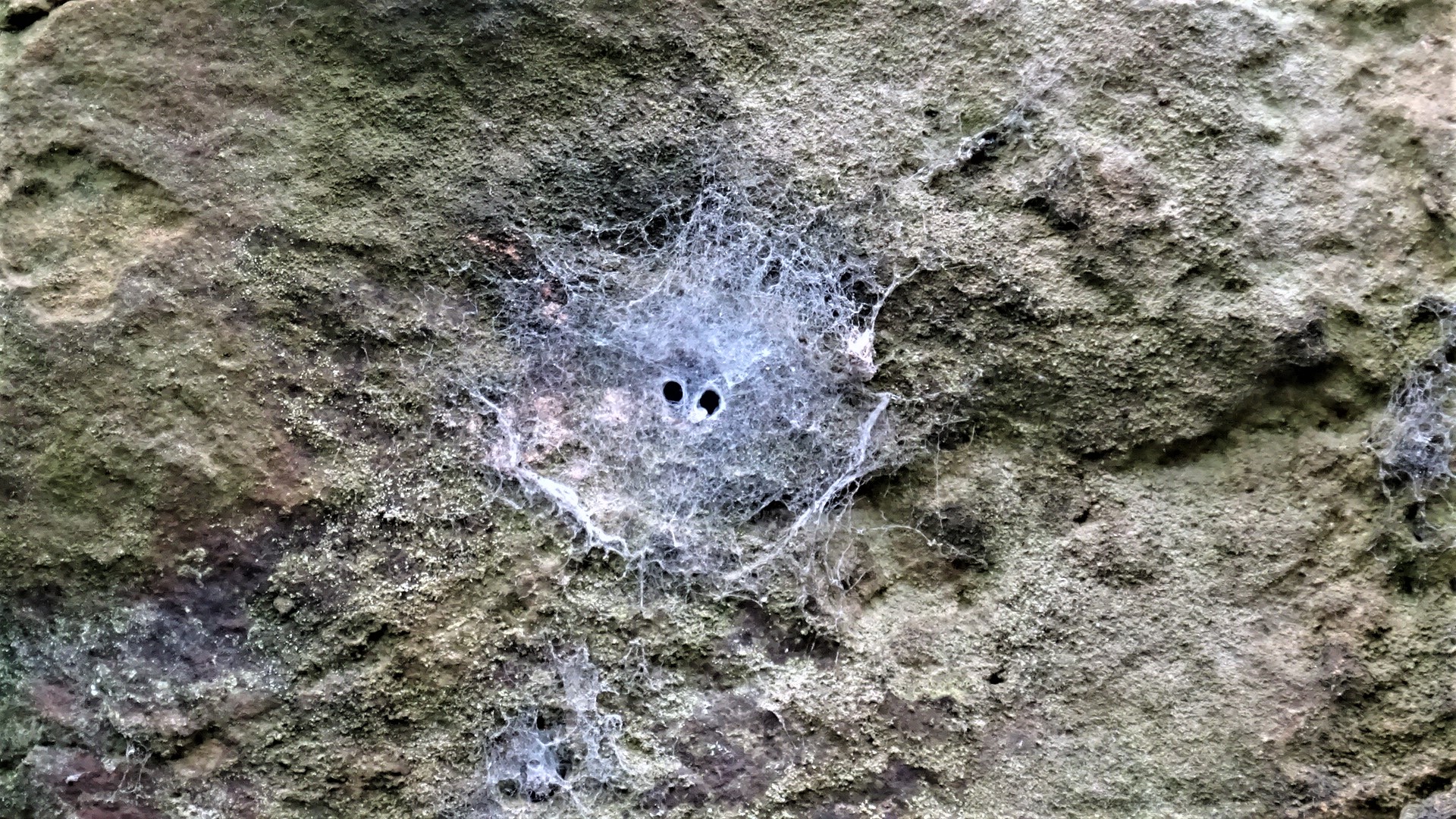
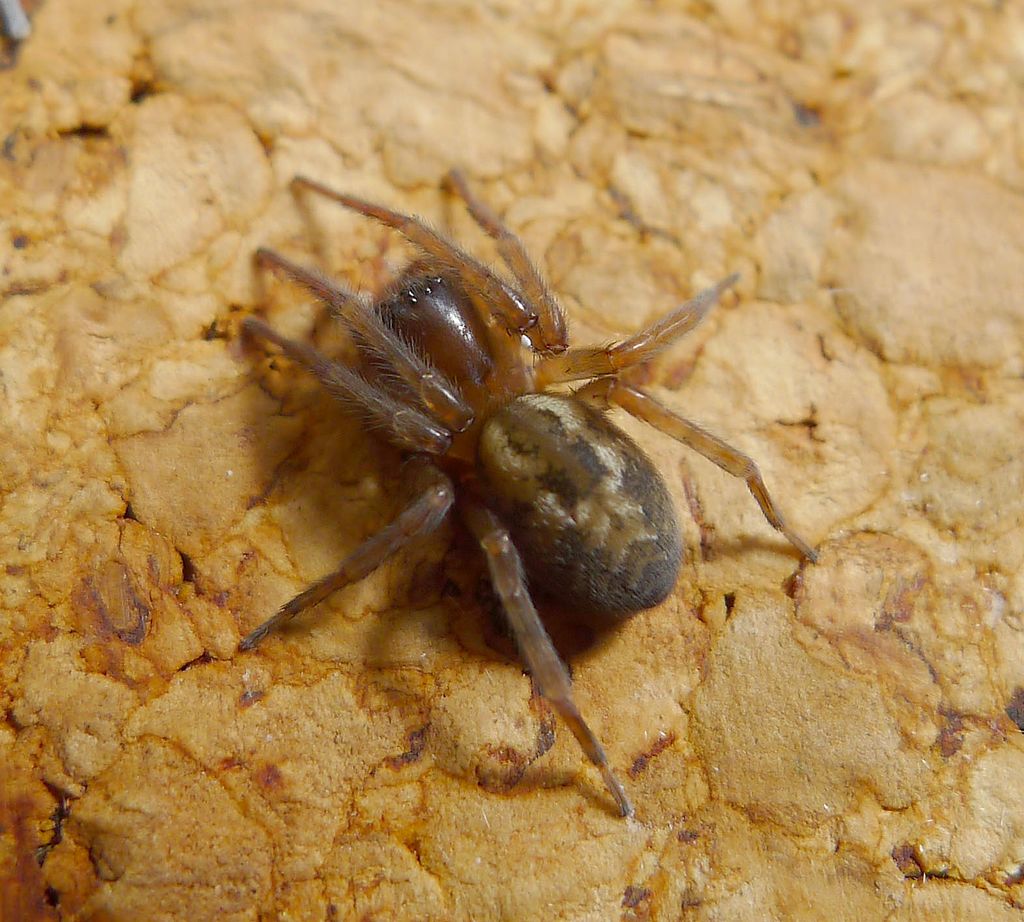
Tube web spider Segestria florentina The shiny green chelicerae are characteristic
Other sources of information
Website
Web site of the British Arachnological Society
Natural History Museum website on web types
Steven Falk's excellent Araneae photos in many albums
British Spiders Facebook Group
British Spider Identification Facebook Group
Books
Bee, L, Oxford, G and Smith, H. (2020) Britain's Spiders: A Field Guide Second Edition. WILDGuides (due September 2020)
Jones, D. (1995). The Country Life Guide to Spiders of Britain and Northern Europe. Country Life Books
Jones-Walters, L.M. (1989) Keys to the families of British spiders. A Field Studies Council AIDGAP key
Roberts, M. J. (2001) Collins Field Guide: Spiders of Britain and Northern Europe. Harper Collins
Roberts, M. J. (1993). The Spiders of Great Britain and Ireland, Compact edition (2 Vols) Harley Books
Page text drafted by Andrew Halstead, reviewed by Andrew Salisbury, extended and compiled by Steve Head
_(27030847182).jpg)
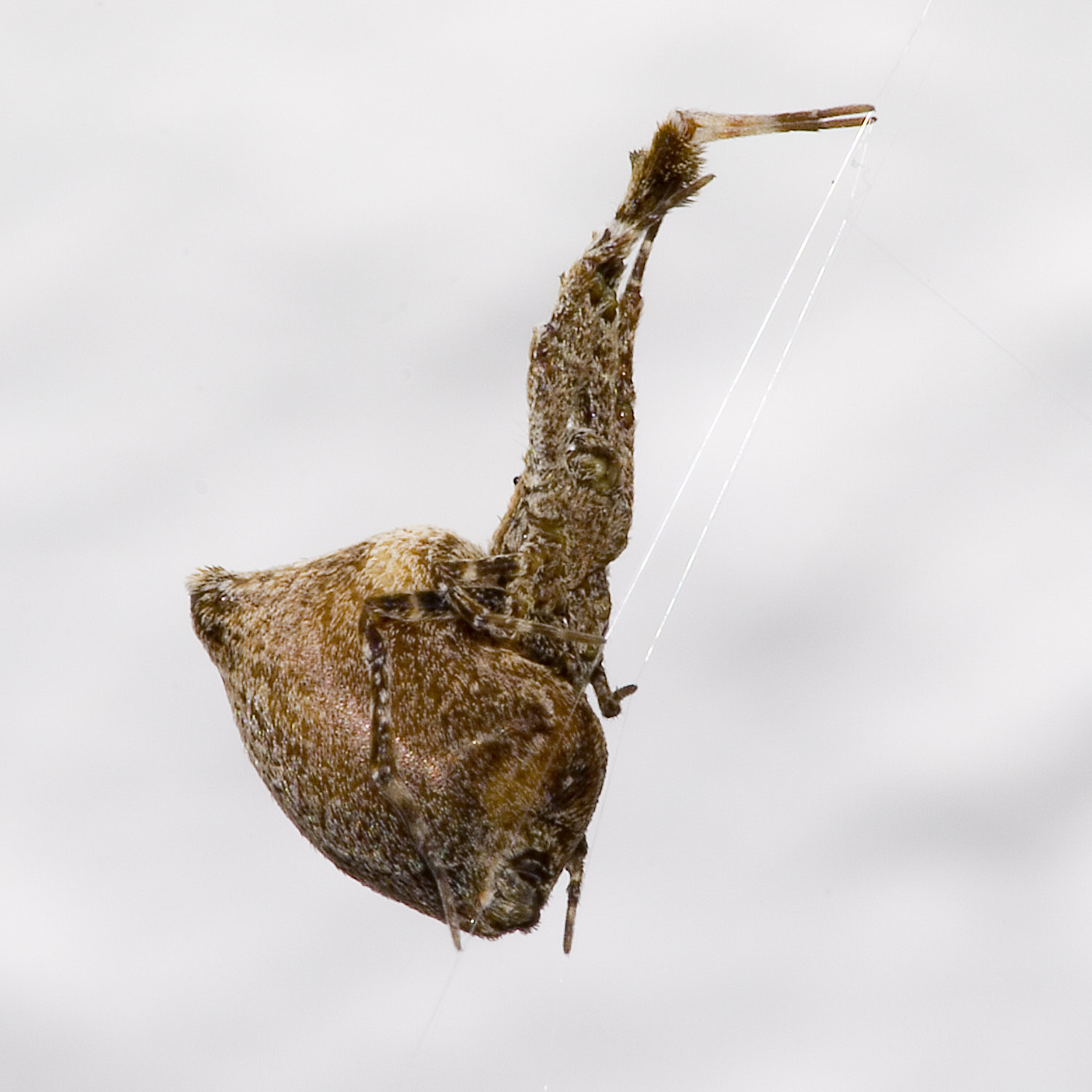
Another interesting orb web builder is the spectacular wasp spider Argiope bruennichi, originally a central European species first recorded in Britain in 1922. It requires warm summers and mild winters to breed successfully, and populations have grown rapidly of late, so it is found across southern England and up into the Midlands. It likes long grass, so isn't likely to be seen in a highly managed garden, but if you let the grass grow it may eventually make an appearance. The characteristic web is embellished with a zig-zag silken structure called the stabilimentum. It's not clear what this is for, but it seems most common in spiders active in daytime, so it may give them some camouflage. It may also deter birds from flying into the web and breaking it.
We have a second new orb web spider in Britain, which you might find on a plant bought from a garden centre. The feather-legged lace weaver Uloborus plumipes (in the family Araneae) originated in the New World, but has become established in garden centres and nurseries where temperatures are always above freezing. It makes a small horizontal web up to 30 cm across, and may become established in warm southern gardens.
Side view of the feather-legged lace weaver Uloborus plumipes, showing the very long first pair of legs stetching upwards, and the oddly shaped abdomen.
Web-building spiders
Web builders are the most familiar spiders for most people, because the webs - scruffy or beautiful and intricate, are so prominent in late summer and autumn, especially on misty or frosty mornings. All spiders have the capacity to make silk (as do many insects), but for web-builders the silk is essential for food procurement. Silk is as tough as nylon, but being made of protein, is "expensive" to produce, so a completed web is a significant investment. The orb web spiders also secrete special sticky silk which they deposit in small drops over the spiral web strands to trap insects. These spiders have an oily deposit on their legs that prvents them from getting stuck in their own trap.
Web building species in Britain and Ireland
Jennifer Owen recorded 50 web building spider species from five families in her Leicester garden. We will describe garden web spiders according to the style of web they produce, which can be orb, sheet, tangle, funnel, lace and radial types. The Natural History Museum has an excellent page on web types here, and this page is arranged folowing their example.
Orb webs are constructed with radial threads that function as a scaffold. The spider then lays down sticky threads in a spiral. Jennifer Owen found orb web spiders from the families Araneidae, and Tetragnathidae in her garden.


Typical orb webs. Left: showing radial and spiral threads, the threads anchoring the structure within vegetation, and the central area where the spider may rest while awaiting prey. Right: a myriad orb webs showing above long grass on a late summer early morning, with dew revealing the webs.
Common orb-web spiders include the large and abundant garden spider Araneus diadematus, the orbweb spider Metellina segmentata and the long-jawed orbweb spider Tetragnatha montana. The missing-sector orbweb spider Zygiella x-notata, a relative of the garden spider, has a distinctive web with a roughly 60 degree sector "missing".

.jpg)
Above left: Garden spider Araneus diadematus Above right: Orbweb spider Metellina segmentata
Below left: Missing-sector orbweb spider Zygiella x-notata and (right) its characteristic web.


.jpg)
Long-jawed orbweb spider Tetragnatha montana
Below: the wasp spider Argiope bruennichi left: gravid female, right: on its web showing the stabilimentum


Another interesting orb web builder is the spectacular wasp spider Argiope bruennichi, originally a central European species first recorded in Britain in 1922. It requires warm summers and mild winters to breed successfully, and populations have grown rapidly of late, so it is found across southern England and up into the Midlands. It likes long grass, so isn't likely to be seen in a highly managed garden, but if you let the grass grow it may eventually make an appearance. The characteristic web is embellished with a zig-zag silken structure called the stabilimentum. It's not clear what this is for, but it seems most common in spiders active in daytime, so it may give them some camouflage. It may also deter birds from flying into the web and breaking it.
We have a second new orb web spider in Britain, which you might find on a plant bought from a garden centre. The feather-legged lace weaver Uloborus plumipes (in the family Araneae) originated in the New World, but has become established in garden centres and nurseries where temperatures are always above freezing. It makes a small horizontal web up to 30 cm across, and may become established in warm southern gardens.

Side view of the feather-legged lace weaver Uloborus plumipes, showing the very long first pair of legs stetching upwards, and the oddly shaped abdomen.
Sheet webs
Orb webs are generally vertical and trap flying insects, but sheet webs are essentially horizontal and catch insects falling into them. These densely woven, thin sheets look like silken hammocks adorning grass and low bushes. Bugs fall onto the hammocks or get knocked down when they collide with a tangle of threads above the sheet.
Sheet webs are usually built by the Linyphiidae. This is the largest family of spiders in the UK, with 280 species. It includes the tiny money spiders said to bring good luck if you find one wandering over you.


Left: Common sheetweb spider underneath its web. Right: money spider Lepthyphantes leprosus
Tangle or mesh webs
As their name suggests, these webs are an iregular 3D tangle of threads. Jennifer Owen found tangle-web spiders from two families of UK spiders: the Dictynidae and Theridiidae .
There are seven species of Dictynidae spider in the UK, of which Jennifer Owen found two. Like several other spider groups they create small, tangled meshes of cribellate or "wooly" silk. This is a non-sticky form of silk produced from spinnerets with many tiny orifices, each producing a single extremely thin strand which is woven in with others rather like rope. The webs ar often built covering flowers and leaves or among leaf litter.
Owen found 7 species of Theridiidae, including the common candy-striped spider Enoplognatha ovata and the comb-footed spider Steatoda bipunctata. This family contains the notorious black widow spiders, and every year the tabloid papers raise unwarranted scares about the noble false-widow spider Steatoda nobilis. This species was first found in England in the late nineteenth century, probably stowing away on a banana boat from its native Madeira and Canary Islands. With climate change, it has spread north from the south coast, and is closely connected with houses which it will enter in cold weather. It can just about pierce human skin, but the "bite" is no worse than a bee sting - but., like bee and wasp stings, can cause a strong immune reponse.


Above. Left: mesh-web spider Dictyna arundinacea showing the tangled web. Right: Common candy-striped spider Enoplognatha ovata with egg sac.
Below. Left: Comb-footed spider Steatoda bipunctata Right: Noble false widow spider Steatoda nobilis


The Pholcidae or cellar-spiders is another tangle-web family. The daddy-long-legs spider Pholcus phalangioides has become common in warm centrally heated houses and has spread north in Britain. Although they favour dark secluded spaces like cellars or under baths, they are occasionally found in gardens. They are often seen in the corners of the ceilings of houses where they make sparse untidy (and generally unpopular) webs. They are easy to identify, from their very long legs and the way they vibrate rapidly up and down when you disturb them, becoming a blur.
In this photo the daddy-long-legs spider Pholcus phalangioides has captured and wrapped-up a western conifer seed bug Leptoglossus occidentalis, which had ventured indoors to hibernate.
Funnel webs
The family Agelenidae make funnel-webs. These are are large sheet of silk which leads to a tube in which the spider lurks. Of the 11 species found in Britain and Ireland only species of Tegeneria are commonly seen in gardens. These are large spiders, with leg spans of 8 up to 17 cm. The males have longer legs but somewhat smaller bodies. Jennifer Owen found Tegenaria gigantea and T. domestica in her garden, there may be as many as 6 species. In practice these spiders are most often seen in houses, especially (and scarily) in the bath, into which they fall but cannot climb out. They are often called bath spiders in consequence.


Left: House spider Tegenaria gigantea lurking in its funnel web. Right: Tegenaria domestica
Lace webs also include a tubular retreat but they use cribellate or "woolly" with a lace-like appearance. The three British and Irish species are in the family Amaurodiidae, genus Amaurobius, and Jennifer Owen found all three. They spread their webs out around holes in walls, tree bark or fences, or under stones and in dense vegetation.
Funnel webs
The family Agelenidae make funnel-webs. These are are large sheet of silk which leads to a tube in which the spider lurks. Of the 11 species found in Britain and Ireland only species of Tegeneria are commonly seen in gardens. These are large spiders, with leg spans of 8 up to 17 cm. The males have longer legs but somewhat smaller bodies. Jennifer Owen found Tegenaria gigantea and T. domestica in her garden, there may be as many as 6 species. In practice these spiders are most often seen in houses, especially (and scarily) in the bath, into which they fall but cannot climb out. They are often called bath spiders in consequence.
Funnel webs
The family Agelenidae make funnel-webs. These are are large sheet of silk which leads to a tube in which the spider lurks. Of the 11 species found in Britain and Ireland only species of Tegeneria are commonly seen in gardens. These are large spiders, with leg spans of 8 up to 17 cm. The males have longer legs but somewhat smaller bodies. Jennifer Owen found Tegenaria gigantea and T. domestica in her garden, there may be as many as 6 species. In practice these spiders are most often seen in houses, especially (and scarily) in the bath, into which they fall but cannot climb out. They are often called bath spiders in consequence.


Lace web made by Amaurobius fenestralis Amaurobius similis
Radial webs
This web is centred on a silken tube, but with single lines of silk radiating away from it. These strands are not sticky to trap prey, but are trip-wires that signal the presence of prey to the urking spider, which then dashes out very quickly to catch it.
Only the family Segestriidae, with three species makes radial webs in Britain. Jennifer Owen did not encounter any in her study. The tube web spider Segestria florentina is one of our largest spiders, with females growing more than two centimetres long. Although restricted to southern England and Wales, mainly around old ports, reports suggest this originally Mediterranean species is spreading further inland
_(27030847182).jpg)
Other sources of information
Website
Web site of the British Arachnological Society
Steven Falk's excellent Araneae photos in many albums
British Spiders Facebook Group
British Spider Identification Facebook Group
Books
Bee, L, Oxford, G and Smith, H. (2020) Britain's Spiders: A Field Guide Second Edition. WILDGuides (due September 2020)
Jones, D. (1995). The Country Life Guide to Spiders of Britain and Northern Europe. Country Life Books
Jones-Walters, L.M. (1989) Keys to the families of British spiders. A Field Studies Council AIDGAP key
Roberts, M. J. (2001) Collins Field Guide: Spiders of Britain and Northern Europe. Harper Collins
Roberts, M. J. (1993). The Spiders of Great Britain and Ireland, Compact edition (2 Vols) Harley Books
Page text drafted by Andrew Halstead, reviewed by Andrew Salisbury, extended and compiled by Steve Head
